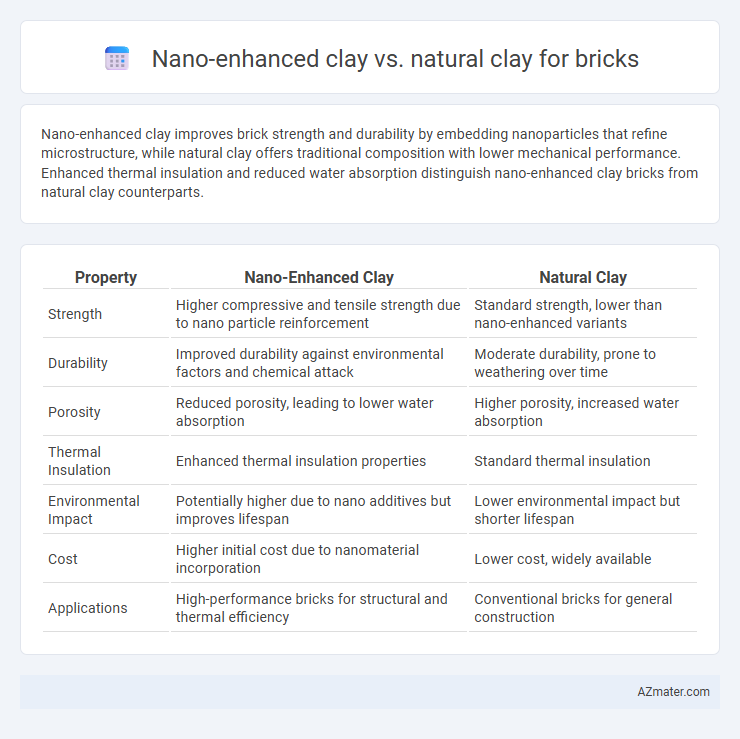Nano-enhanced clay improves brick strength and durability by embedding nanoparticles that refine microstructure, while natural clay offers traditional composition with lower mechanical performance. Enhanced thermal insulation and reduced water absorption distinguish nano-enhanced clay bricks from natural clay counterparts.
Table of Comparison
| Property | Nano-Enhanced Clay | Natural Clay |
|---|---|---|
| Strength | Higher compressive and tensile strength due to nano particle reinforcement | Standard strength, lower than nano-enhanced variants |
| Durability | Improved durability against environmental factors and chemical attack | Moderate durability, prone to weathering over time |
| Porosity | Reduced porosity, leading to lower water absorption | Higher porosity, increased water absorption |
| Thermal Insulation | Enhanced thermal insulation properties | Standard thermal insulation |
| Environmental Impact | Potentially higher due to nano additives but improves lifespan | Lower environmental impact but shorter lifespan |
| Cost | Higher initial cost due to nanomaterial incorporation | Lower cost, widely available |
| Applications | High-performance bricks for structural and thermal efficiency | Conventional bricks for general construction |
Introduction to Clay in Brick Manufacturing
Nano-enhanced clay in brick manufacturing incorporates nanoparticles to improve the microstructural properties, resulting in higher strength, durability, and reduced porosity compared to natural clay. Natural clay, traditionally used in brick production, offers good plasticity and workability but may have limitations in mechanical performance and weather resistance. The integration of nanotechnology in clay materials optimizes thermal insulation and compressive strength, enhancing overall brick quality and longevity.
What is Nano-Enhanced Clay?
Nano-enhanced clay incorporates nanoparticles, such as nano-silica or nano-alumina, to improve the physical and mechanical properties of traditional clay used in brick manufacturing. These nanoparticles fill micro-pores in the clay matrix, enhancing strength, durability, and moisture resistance compared to natural clay bricks. Utilizing nano-enhanced clay results in bricks with superior compressive strength, reduced water absorption, and increased thermal stability, making them more suitable for advanced construction applications.
Properties of Natural Clay Bricks
Natural clay bricks exhibit high compressive strength, excellent thermal insulation, and superior durability, making them a reliable building material in various construction projects. Their porous structure allows for effective moisture regulation and breathability, enhancing indoor air quality and preventing mold growth. Additionally, natural clay bricks offer eco-friendly properties due to their biodegradable composition and energy-efficient manufacturing process.
Structural Advantages of Nano-Enhanced Clay Bricks
Nano-enhanced clay bricks exhibit significantly improved mechanical strength and durability compared to natural clay bricks, due to the incorporation of nanoparticles that enhance particle bonding and reduce porosity. These structural advantages result in higher compressive strength, better resistance to weathering, and increased load-bearing capacity, making them ideal for long-lasting construction. Moreover, the nano-modification imparts superior thermal insulation and fire resistance properties, enhancing overall building safety and energy efficiency.
Thermal Performance Comparison
Nano-enhanced clay bricks exhibit significantly improved thermal insulation properties compared to natural clay bricks due to the incorporation of nanoparticles that reduce thermal conductivity. Studies indicate that nano-enhanced clay can lower heat transfer rates by up to 30%, resulting in better energy efficiency and indoor temperature regulation. The enhanced thermal performance supports sustainable building practices by minimizing the need for artificial heating and cooling.
Durability and Longevity Analysis
Nano-enhanced clay bricks exhibit significantly improved durability and longevity compared to natural clay bricks, due to the incorporation of nanoparticles that enhance the microstructure and reduce porosity. Studies show a 20-30% increase in compressive strength and resistance to weathering agents, which translates to longer service life under harsh environmental conditions. The enhanced bonding at the molecular level in nano-clay composites minimizes crack formation and moisture absorption, further extending the brick's lifespan beyond that of conventional natural clay alternatives.
Environmental Impact and Sustainability
Nano-enhanced clay bricks exhibit superior environmental sustainability by reducing energy consumption during production due to their enhanced thermal insulation properties and faster curing times. Natural clay bricks, while biodegradable and widely available, often require higher firing temperatures, resulting in greater carbon emissions and resource depletion. The integration of nanoparticles in clay bricks promotes durability and longevity, minimizing the frequency of replacements and reducing overall environmental footprints.
Cost Implications: Nano-Enhanced vs Natural Clay
Nano-enhanced clay bricks often incur higher initial manufacturing costs due to the incorporation of nanomaterials and advanced processing techniques, whereas natural clay bricks benefit from established, less expensive production methods. Despite the upfront expenses, nano-enhanced bricks can reduce long-term costs through improved durability, thermal insulation, and reduced maintenance requirements, offering better overall lifecycle value. Natural clay bricks remain a cost-effective choice for projects prioritizing immediate budget constraints over enhanced performance benefits.
Industrial Applications and Market Trends
Nano-enhanced clay offers superior mechanical strength and thermal insulation properties compared to natural clay, making it highly suitable for advanced industrial brick manufacturing. The integration of nanomaterials improves durability, reduces porosity, and enhances chemical resistance, driving increased adoption in industrial sectors requiring high-performance construction materials. Market trends indicate a growing shift towards nano-enhanced clay bricks due to rising demand for sustainable and energy-efficient building solutions, with Asia-Pacific leading the market growth fueled by rapid urbanization and infrastructure development.
Future Prospects in Brick Technology
Nano-enhanced clay offers significant improvements in brick technology by enhancing mechanical strength, thermal insulation, and durability compared to natural clay. Future prospects include the integration of nanomaterials like nano-silica and nano-alumina to create eco-friendly, energy-efficient bricks with superior performance and reduced carbon footprints. Advances in nanotechnology and material science are expected to drive cost-effective production methods, enabling widespread adoption in sustainable construction.

Infographic: Nano-enhanced clay vs Natural clay for Brick
 azmater.com
azmater.com